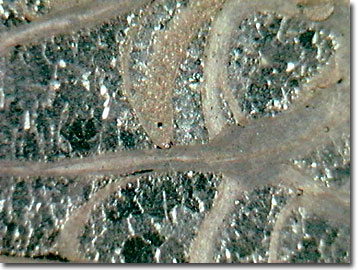Darkfield Digital Image Gallery
Ancient Cnidaria Fossil
The phylum Coelenterata, also known as Cnidaria, includes the marine corals, sea fans, sea pens, sea anemones, hydras, and jellyfish. Hydras also have freshwater representatives and are the exception in the coelenterate taxon since they do not exhibit a medusa or "jellyfish" life stage. Specialized stinging cells known as nematocysts or cnidae (thus, the alternative phylum name) are used to capture, hold, and reel in prey, as well as to assist in locomotion and defense.

View a low magnification image of an ancient Cnidaria fossil.
View a medium magnification image of an ancient Cnidaria fossil.
Capable of either asexual or sexual reproduction, coelenterates are primitive invertebrates characterized by the radial symmetry typical of sessile, benthic filter feeders. In similarity to sponges, coelenterates are often colonial, but the tiny hydras are capable of living freely as individuals. Some coelenterates are free-swimming, such as the Portuguese man-of-war and the jellyfishes, while many species of hydroids are capable of some forms of mobility, including creeping slowing while sliding on their basal discs, or locomoting more rapidly in a series of somersaults or looping movements.
The poisonous tentacles of fire coral, jellyfishes, and the hydrozoan Portuguese man-of-war deliver painful stings upon contact with human skin, although they are intended for paralyzing fish and other small prey. If washed with fresh water, the stinging cells excrete even more irritants. Counterintuitively, a vinegar wash of the jellyfish stings is recommended as first aid before seeking medical advice. The venom associated with the skin-piercing nematocysts is highly toxic and in some cases, lethal to human victims.
Contributing Authors
Cynthia D. Kelly, Thomas J. Fellers and Michael W. Davidson - National High Magnetic Field Laboratory, 1800 East Paul Dirac Dr., The Florida State University, Tallahassee, Florida, 32310.
BACK TO THE DARKFIELD IMAGE GALLERY
BACK TO THE DIGITAL IMAGE GALLERIES
Questions or comments? Send us an email.
© 1995-2025 by Michael W. Davidson and The Florida State University. All Rights Reserved. No images, graphics, software, scripts, or applets may be reproduced or used in any manner without permission from the copyright holders. Use of this website means you agree to all of the Legal Terms and Conditions set forth by the owners.
This website is maintained by our
Graphics & Web Programming Team
in collaboration with Optical Microscopy at the
National High Magnetic Field Laboratory.
Last Modification Friday, Nov 13, 2015 at 01:19 PM
Access Count Since September 17, 2002: 8693
Visit the website of our partner in introductory microscopy education:
|
|
